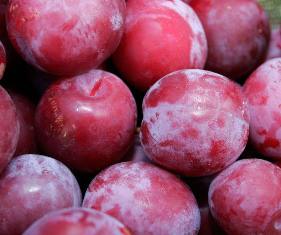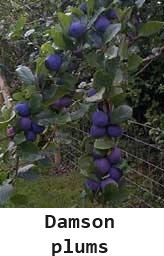
Plum U-Pick Orchards in Sussex in 2025, by county
Below are the PYO orchards and farms for plums that we know of in this area. Not all areas have plums orchards or farms that are open to the public. If you know of any others, please tell us using the add a farm form!
Remember to always check with the farm's own website or Facebook page before you go - or call or email them if they don't have a website or Facebook page. Conditions at the farms and crops can change literally overnight, so if you want to avoid a wasted trip out there - check with the farm directly before you go! If I cannot reach them, I DON'T GO!
PLEASE report closed farms, broken links and incorrect info using the "Report Corrections" form below.
East Sussex
- Kent
& Sussex Apple Juice and Cider Centre - PYO: Apples,
plums, blackberries, blackcurrants, gooseberries
Perryhill Orchard, Edenbridge Road, Hartfield. Phone: 01892 770595. Open: Although not available this year, P.Y.O. is usually available between June and October from a variety of soft fruits, apples, and pears. When we do resume PYO again in the future you will be able to enjoy picking: Blackberries, plums (Czar, Victoria, Valour, and Marjorie seedlings), Apples (Discovery, Katy, James Grieve, Perryhill Pippin, Cox’s Orange Pippin, Golden Delicious, Bramley, Egremont Russet, Spartan, Red Jonathan, Winston, Jonagold)
Pears (Conference, Concorde, Comice), We apologise for any inconvenience. Directions: Equidistant (5m) Tunbridge Wells & E Grinstead. On B2026 1 mile N of Hartfield village. Commercial fruit farm with farm shop and PYO; home deliveries possible; also at local farmers' markets. The farm shop has Orchard & soft fruits, fresh vegetables, free range eggs, preserves, honey, local and other wines, fruit juices. Facilities: Ample parking, scenic walks, easy access for disabled. (UPDATED: July 10, 2015, JBS) - Maynards
PYO - PYO: Apples,
apricots, cherries, plums, damsons strawberries, blackcurrants, blackberries,
raspberries, loganberries, tayberries, rhubarb,
cobnuts, Tummelberries
Windmill Hill Farm, Cross Lane, Ticehurst near Wadhurst. Phone: 01580 200394. Open: 9 am to 6 pm, see their website or call to check availability. The farm shop has a small shop open only during the PYO season with pre-picked items only. Facilities: Ample parking, toilets, easy access for disabled, nearby pub.
Morellos (cherries) We are one of the longest established Pick your own fruit farms in the UK, based in East Sussex. We are proud to have created a farm that all the family can enjoy - and once you've had your fill of fruit picking, head down to our shed for a delicious apple juice or scoop of Maynards very own ice cream. (UPDATED: June 21, 2020, JBS)
West Sussex
-
Grange Farm Shop and PYO - Apples, currants (red and black),
gooseberries, pears, plums, rhubarb, strawberries, Other fruit or veg,
U-pick and already picked, gift shop
Grange Farm, Funtington, Near Chichester, PO18 9LN. Phone: 01243575372. Email: enquiries@grangefarmshop.com. Open: PYO open Monday to Saturday 9 am to 4 pm according to crop availability which is usually May to late October; Our farm shop is open Monday to Saturday 9 am to 5 pm all year. . Directions: Grange Farm is situated at the western edge of the village of Funtington only five miles from Chichester. The orchard and PYO is on the south side of the road with the shop on the north side. There is plenty of parking on both sides of the road. Click here for a map and directions. Free tastings of our fruit always available. Payment: Cash, Cheque, Debit cards, Visa/MasterCard. We also grow rhubarb, gooseberries, asparagus, damsons greengages. 11 varieties of apples, 8 varieties of plums, and 4 varieties of pears. Our farm shop stocks a wide range of foods and gifts. We also stock cheeses, locally baked cakes and bread, biscuits, pies, preserves, our own fruit juices, honey, smoked fish, cards and presents. We support local farmers and British manufacturers. The shop is lively and interesting and as far removed from a supermarket as it is possible to be so if you care about food miles you will enjoy shopping with us. (UPDATED: July 9, 2015, JBS) (UPDATED: August 01, 2011) (ADDED: May 22, 2008)
Plum, Damson and Gage Picking Tips, Recipes and Information
In the U.K., Plums Damsons and Gages typically peak during July for Sugar Plums; August for Blue, Yellow and Red Plums. In order to produce good local plums, producers depend on ideal spring and early summer weather conditions, and no late frosts. If you are looking for a plum festival, see this page.
Before you leave to go to the farm:
- Always call before you go to the farm - Plums are affected by weather (both rain and cooler temperature) more than most crops. And when they are in season, a large turnout can pick a field clean before noon, so CALL first!
- Leave early. On weekends, then fields may be picked clean by NOON!
-
Some growers furnish picking containers designed for plums, but they may
charge you for them; be sure to call before you go to see if you need to
bring
containers.
If you use your own containers, remember that heaping Plums more than 14 inches deep will bruise the fruit on the bottom. Plastic dishpans, metal oven pans with 3 inch tall sides and large pots make good containers. - Bring something to drink and a few snacks; you'd be surprised how you can work up a thirst and appetite! And don't forget hats and sunscreen for the sun. Bugs usually aren't a problem, but some deet might be good to bring along if it has been rainy.
- You might want to ask whether the plums are! There are two major types of plums: "Freestone" and. "Clingstone". Freestone plums have flesh that slips easily away from the pit. Clingstones are a REAL pain, because the fruit tenaciously clings to the stone or pit! Most plum varieties grown today are freestone and are usually available (depending upon your location) from June through September. Some nectarines are freestone and some are clingstone. Freestone nectarines are available in June and July. Most plum varieties are clingstone.
Tips on How to Pick Plums
A plum is softer than most fruit, so it is important to pick a plum gently, with little pressure. Using the sides of your fingers rather your fingertips helps to avoid bruising. Grab the plum firmly and pull it straight off the branch. DON'T drop the plum into the basket, but set it in gently!
Picking Tips:
How to tell if the plums are ripe!
- Attached to the tree: Plums are best picked when the fruit separates easily from the twigs. If it is hard to pull off the tree, it isn't ripe! Plums will not ripen further once removed from the tree (they only "soften")
- Color: Green is definitely unripe, but you can't use red color as an indicator of how ripe a plum is. Different plum varieties have differing colours, darker is usually better in any variety. Pick them when the ground color changes from green to yellow, orange, red or even blue or purple (or a combination).
- Softness: unless you like your plums very firm, pick your plums with just a little "give" when gently pressed. Plums at this stage are great for eating, freezing, and baking. Plums won't ripen very much after picking!
- Odor: It should smell sweet and ripe!
- Larger plums are riper.
- Sugar plums grow in clusters, so carefully select the plum you want out of the cluster.
- Place them gently in a shallow wide container, no more than 8-inches deep, to avoid crushing the fruit.
Marks on the Plums: Bugs (particularly squash bugs and stink bugs)
bite fruit during development and this results in some imperfections in the
plum. This is especially the case with organically raised fruit. These
look like dents in the plums if the plums were bitten by a bug when they
were young. This causes a spot that does not grow properly and makes a wrinkle
in the plum. There's nothing wrong with these plums. They may look funny, but
they will taste just as good as blemish-free plums, and it's better not to
have the pesticides!
When you get home
- Spread the fruit out on towels or newspapers and separate any mushy or damaged fruit to use immediately.
- Put a couple of days supply into the fridge, wash and cut the others and freeze them up!
- Even under ideal conditions plums will only keep for a week in a refrigerator, so for best flavor and texture, use them as soon as possible after purchase
Make preserves, can or freeze!
Easy directions, step by step, with photos
- plum jam
- plum jelly
- canned plums
- freeze plums
- canned plum pie filling to use in the winter
- plum pie recipe
- plum-blueberry pie
- plum salsa
- Plum chutney
- Spiced plums
- Plum butter
- Pickled plums
- Here are some great and easy plum desert recipes, like easy plum cobbler..
Plum dessert recipes
- Plum Cobbler
This recipe is easy and DELICIOUS!!! - Plum Torte
- Italian Prune Plums (Empress Plums)
How much do you need?
Raw measures:
- About 2 medium plums = 1/2 cup sliced plums.
- About 4 medium plums = 1 /2cup pureed plum.
- About 3 medium plums = 1 /2 pound of plums
Process yields (Raw amounts to processed amounts)
- 2 to 21/2 pounds of fresh plums yields 1 quart canned
- 1 lb of fresh plums typically yields 3 cups of peeled, sliced plums or 2 cups or puree.
- It takes about 10 plums to fill one quart jar of canned plums.
- An average of 171/2 pounds of fresh plums are needed per canner load of 7 quarts;
- An average of 11 pounds is needed per canner load of 9 pints.
- 1 bushel = 48 to 50 pounds, yields approximately 18 to 25 quart jars.
Plums-Average retail price per pound and per cup equivalent
Plum pit tips
It's best to remove plum pits before you cook the plums. Cherry, plum, and apricot pits also contain amygdalin; the latter two, in potentially harmful amounts. Fortunately, plum and apricot pits are sufficiently large and hard that few people intentionally swallow or chew them. (The unapproved anti-cancer drug Laetrile is a semisynthetic derivative of amygdalin; a cheaper version of laetrile produced in Mexico came from crushed apricot pits.) See this page for more information.
Nutritional Information
- plums are virtually fat free. A medium size plum contains less than one gram of fat.
- plums are naturally sodium free.
- plums have no cholesterol.
- plums are a low calorie snack. A medium size plum contains only 40 calories.
- plums contain vitamin A which helps us see in dim light.
- plums are considered a good source of fiber. The skin of a plum provides both roughage and fiber.
Temporary Storage Tips
- Ripe plums have a creamy or golden undertone and "plumy-sweet" fragrance.
- Plums should be refrigerated and used within a few days.
- Putting plums in a loosely closed paper bag at room temperature for a day or two can help soften firm fruit - but they won't become sweeter or ripen further - that stopped when they were removed from th etree.
- For best flavor, allow the fruit to ripen fully on the tree.
- Store at 33 F to 40 F and high humidity (a vegetable drawer in the fridge).
Click here for farmshops in this area